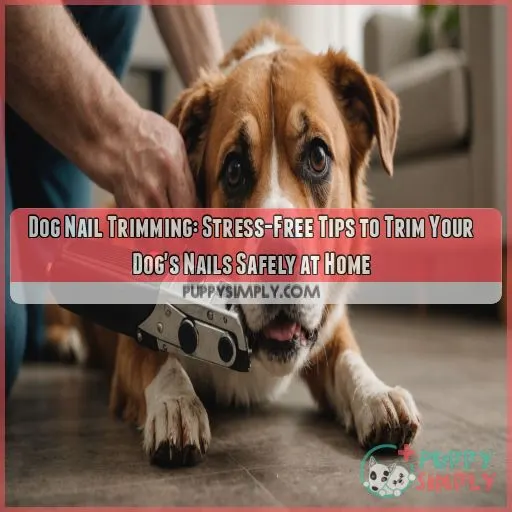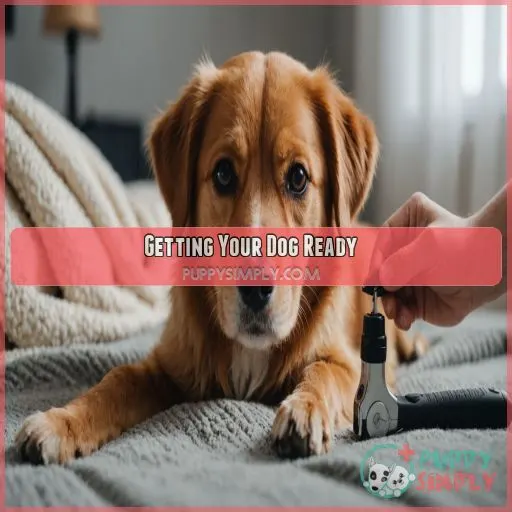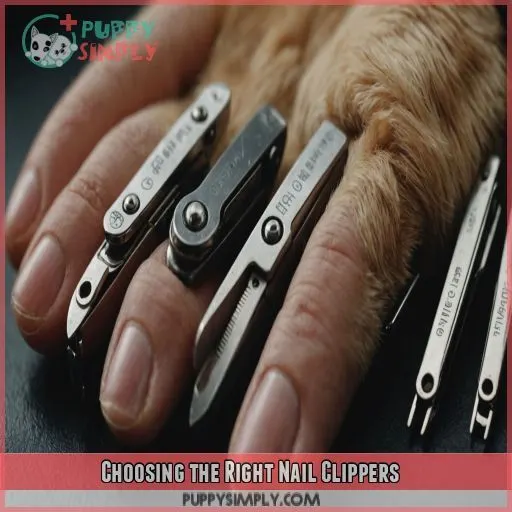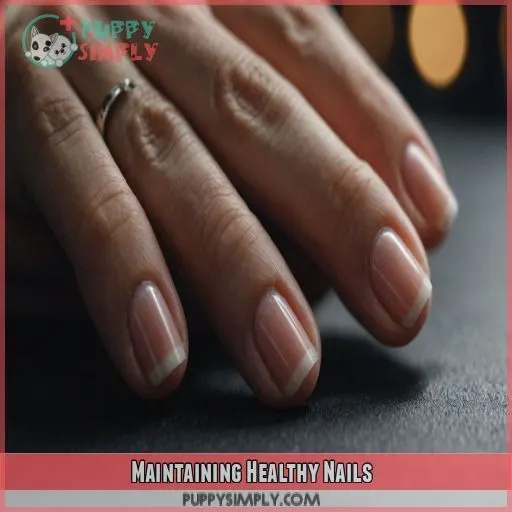This site is supported by our readers. We may earn a commission, at no cost to you, if you purchase through links.
 Nail trimming doesn’t have to be a nightmare for you or your dog.
Nail trimming doesn’t have to be a nightmare for you or your dog.
First, get your dog comfortable with paw handling.
Touch their paws often, massage their legs, and offer treats to create positive associations.
Gradually introduce them to the nail clippers, starting with short exposures and increasing the time they’re visible and handled.
Always use positive reinforcement with treats and praise when they remain calm.
Choose the right clippers for your dog’s size and nail thickness.
You’ll learn more about nail trimming techniques and how to handle common challenges if you keep reading.
Table Of Contents
Key Takeaways
- You’re not alone in the nail-trimming struggle! Start by getting your furry friend comfortable with paw handling. It’s like giving them a spa day – massage their paws, offer treats, and before you know it, they’ll be begging for a mani-pedi.
- Choose the right tools for the job. Just like you wouldn’t use hedge clippers for your own nails, pick clippers that fit your dog’s size and nail type. Think of it as finding the perfect pair of shoes – comfort is key!
- Take it slow and steady. Rome wasn’t built in a day, and your dog won’t become a nail-trimming pro overnight. Use positive reinforcement, give lots of treats, and celebrate small victories. Soon, nail-trimming time will be as exciting as walk time (well, almost).
- Don’t panic if you make a mistake. If you accidentally cut the quick, it’s not the end of the world. Apply some styptic powder, give extra cuddles, and remember – even professional groomers have off days. You’ve got this!
Getting Your Dog Ready
You’re about to take a big step in dog nail trimming: getting your furry friend ready for the process. By gradually introducing your dog to paw touch, nail handling, and positive reinforcement, you’ll set the stage for a stress-free and safe nail-trimming experience at home.
Desensitizing Your Dog to Paw Touch
Getting your dog comfortable with paw handling is key to stress-free nail trims.
It’s all about positive touch and a gradual approach.
Start by simply touching their paws for a few seconds at a time, offering treats and praise as you go.
This reward system helps your dog associate paw handling with good things.
Slowly work your way up to holding their paw, always taking things at their pace.
It’s a fear-reduction technique that sets the foundation for safe and calm nail trims.
Helping Your Dog Get Used to Nail Handling
It’s important to help your dog feel comfortable with nail handling before you start trimming. Here’s how you can do it:
- Touch Their Paws Often: Make paw-handling part of your daily petting routine. Touch their paws gently and give treats to create positive associations.
- Massage Their Legs: Give your dog a leg massage, including their paws and nails. This helps them relax and gets them used to touch.
- Handle Their Nails: Gently hold each nail between your fingers. This gets them accustomed to the feeling of nail trimming.
Positive Reinforcement Techniques for Nail Trimming
Now that your dog is comfortable with nail handling, it’s time to introduce positive reinforcement techniques. Use clicker training to create a reward schedule that associates nail trimming with treats and praise. Start with small steps, like simply showing your dog the clippers, and gradually increase exposure while maintaining a positive association with praise cues and treat motivation.
Choosing the Right Nail Clippers
Now that your dog is comfortable with having their paws handled, it’s time to pick the right tool for the job.
A good pair of nail clippers can make all the difference in a stress-free trimming experience.
With so many types of clippers available, choosing the right one for your dog’s size, breed, and nail type can be overwhelming.
Don’t worry, we’ll help you find the perfect fit.
Types of Dog Nail Clippers Available
Now that your dog is comfortable with paw handling, it’s time to choose the right nail clippers. You’ve got options: guillotine, scissor, grinder, plier, and electric. Guillotine clippers are great for small breeds, while scissor clippers work well for larger dogs. Grinders and electric clippers are perfect for smoothing out rough edges. Plier clippers are ideal for thick nails.
Selecting Clippers Based on Dog Size and Breed
Now that you know the types of clippers out there, it’s time to pick the right one for your furry friend. Consider your dog’s size and breed when choosing clipper size. Larger breeds need bigger clippers, while smaller breeds require smaller ones. Think about your dog’s nail type too – thicker nails need sharper clippers.
Features to Look for in a Good Nail Clipper
Choosing the right nail clippers for your pooch can be tricky, but there are a few key features that make the process easier.
First up, you want blades sharp enough to slice through a loaf of bread (but be careful!).
Go for clippers with a comfy grip so you can easily wrangle your dog’s nails.
Safety features are a must—no one wants a clawed face.
Also, consider the cutting capacity and opt for a trusted brand.
Step-by-Step Nail Trimming Guide
Now that you’ve got the right tools, let’s get trimming! We’ll take you through the process step-by-step, from preparing your pup to dealing with common challenges like black nails and rewarding good behavior.
Preparing Your Dog for the First Trim
Now that you’ve got the right nail clippers, it’s time to prepare your dog for the first trim. To make it a positive experience, consider your dog’s age and comfort zone. Here are a few things to keep in mind:
- Start with short sessions to help your dog get used to the nail trimming tools.
- Reward calm behavior with treats and praise.
- Gradually increase exposure to the clippers to build confidence.
Trimming the Nails Safely and Correctly
Now that your dog is prepared, it’s time to trim those nails safely and correctly. Hold your dog’s paw firmly but gently, and place the clippers so that they’re parallel to the nail. Trim a little at a time, taking breaks to give treats and praise. Follow this step-by-step guide to make sure you have a stress-free experience.
| Step | Action |
|---|---|
| 1 | Hold paw firmly but gently |
| 2 | Place clippers parallel to nail |
| 3 | Trim a little at a time |
| 4 | Give treats and praise |
| 5 | Repeat for all four paws |
Dealing With Black Nails and Quick
Black nails can be a challenge, but it’s no biggie once you know what to do.
It’s all about identifying the quick, that’s the pinkish part with blood vessels and nerves.
If you cut into it, it’ll bleed, and your pup will feel pain.
So, the trick is to take it slow and steady.
First, identify the bottom of the nail where it starts to curve.
Then, clip only the very tip, bit by bit, until you see a black dot, which is the start of the quick.
Rewarding Good Behavior During Trimming
Positive reinforcement is key. After each trim, give your dog a treat and heaps of praise. This encourages good behavior and creates a positive association with nail trimming.
If your dog struggles, try clicker training. Mark the behavior with a click, then reward. Follow a consistent reward schedule, and soon your dog will associate the click with treats, making it easier to mark good behavior accurately.
Overcoming Common Challenges
Nail trimming can be a challenge, especially if your dog is anxious or aggressive about the process. You may also run into issues like cutting the quick, which can be painful and scary for your pup.
Dealing With Fear and Anxiety in Dogs
You’re not alone if your dog freaks out at nail trimming time. Many dogs experience fear and anxiety, but with the right approach, you can help calm them down. Here are some tips:
- Watch for anxiety triggers, such as raised hackles or avoidance behaviors, and adjust your approach accordingly.
- Use calming techniques like gentle petting, soothing talk, or calming aids like pheromone diffusers.
- Desensitize your dog to nail handling with gradual exposure and positive reinforcement.
- Pay attention to body language and take breaks if your dog shows signs of stress.
Managing Aggression During Nail Trimming
When dealing with aggression during nail trimming, watch for dog body language cues like growling, snapping, or raised hackles. Identify aggression triggers, such as pain or fear, and adjust your approach. Use safe handling techniques, like gentle restraint, and consider reward system alternatives. If aggression persists, seek professional help from a veterinarian or animal behaviorist.
What to Do if You Cut the Quick
If you cut the quick, don’t panic! It’s a common mistake. Stop the bleeding with styptic powder and give your dog a break. Remember, it’s not a big deal, and it won’t affect nail growth. For future trims, take note of where the quick is and trim more carefully. Watch your dog’s reaction and adjust your approach accordingly.
Handling Sensitive or Painful Paws
If your dog has sensitive or painful paws, don’t stress! To manage paw sensitivity, try gently massaging their paws with a soothing balm or oil. For pain management, consider a topical anesthetic cream or consult with your vet. Prioritize paw care by avoiding extreme temperatures and rough surfaces. Your furry friend will thank you for the TLC.
Maintaining Healthy Nails
Now that you’ve mastered the art of trimming your dog’s nails, it’s time to think about maintaining those healthy nails in the long run.
How Often to Trim Your Dog’s Nails
Trimming frequency depends on your dog’s nail growth rate, age, and breed. Generally, trim your dog’s nails every 4-6 weeks. Puppies need more frequent trims, while seniors may need less. Some breeds, like larger dogs, may need more frequent trims due to faster nail growth. Keep an eye on your dog’s nail length to determine the best trimming schedule.
Signs of Healthy and Unhealthy Nails
Healthy nails are typically a pale pink color, with a hint of transparency, and have a smooth, slightly curved shape.
Unhealthy nails can exhibit warning signs like nail splitting, unusual nail texture, discoloration, or changes in nail growth.
Keep an eye out for these signs and take your dog to the vet if you spot anything unusual.
It’s also a good idea to ask your vet for advice on maintaining healthy nails through proper nail care and nutrition.
Preventing Nail Problems Through Diet and Exercise
A healthy diet and regular exercise aren’t just about your dog’s waistline; they’re really important for healthy nail growth and strong, flexible paws. Here’s how:
- Diet for Nail Health: Make sure your pup’s diet includes omega-3 fatty acids (think salmon or fish oil supplements) and biotin-rich foods like eggs and liver for stronger nails.
- Exercise for Nails: Daily walks and runs help wear down nails naturally, preventing overgrowth.
- Joint Health: Support joint health with glucosamine and chondroitin supplements, especially if your dog is older or large-breed, to encourage comfortable movement and nail-strengthening exercise.
A healthy body supports healthy paws!
Frequently Asked Questions (FAQs)
How often should I trim my dogs nails?
How often should you trim your dog’s nails?" Now, that’s a tricky question. It depends on your dog’s activity levels and nail growth. Aim for once a month, but check their nails every week.
What if I cut the quick?
If you accidentally cut the quick, don’t panic! Apply styptic powder or cornstarch to stop bleeding. Comfort your pup and give treats. Next time, trim less and use a flashlight to see the quick better.
Any tips for a nervous dog?
Did you know 70% of dogs dislike nail trims? For your nervous pup, start slow. Reward calm behavior, use treats liberally, and practice touching paws when relaxed. You’ll turn nail time into bonding time before you know it!
Are dog nail trims painful?
Don’t worry! Nail trims aren’t painful when done correctly. It’s like trimming your own nails. The key is avoiding the quick, the sensitive part inside. With practice and patience, you’ll be a pro in no time!
What about grinding vs. clipping?
Like choosing between a sports car and a bicycle, grinding and clipping have their pros. Grinding’s gentler but takes longer; clipping’s quicker but riskier. Try both to see what your pup prefers. You’ll find your groove together!
Conclusion
Did you know that 80% of dogs show anxiety during nail trimming?
But with patience and practice, you can make dog nail trimming a stress-free experience.
Start slowly, use positive reinforcement, and choose the right tools.
With time, you’ll both become pros at this essential grooming task.
Keep those paws healthy and your furry friend happy.
Who knows? Your dog might even start looking forward to their manicure sessions!











